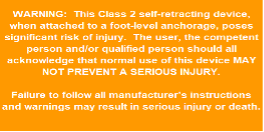Is it mandatory that I must update my existing SRDs to the new ANSI/ASSP Z359.14-2021 standard revision after the August 01, 2023 effectivity date arrives?
No, existing SRD equipment manufactured to previous revisions of the ANSI Z359.14 standard may continue to be used, provided the product continues to meet all inspection requirements as defined by the manufacturer’s instructions for use, and conducted at the recommended intervals by a Competent Person.
Can distributors still sell SRDs after the August 01, 2023 effectivity date arrives?
Even after August 01, 2023, a distributor can continue to sell any existing inventory of their SRDs as long as those devices have a manufacturing date of prior to August 01, 2023. Any SRDs manufactured after August 01, 2023 shall be certified to the new ANSI/ASSP Z359.14-2021 standard by the manufacturer, in order to be sold to end users.
Are there new Self-Retracting Lifeline (SRL) categories established under this Standard revision?
Yes, ANSI/ASSP Z359.14-2021 is updated to have three Self-Retracting Lifeline categories
- SRL (Self-Retracting Lifeline) – for standard or leading edge applications
- New: SRL-P (Personal SRL) – mounted on harness and for standard or leading edge applications
- SRL-R (Retrieval Self-Retracting Lifeline) – SRL with retrieval or rescue functionality
SRL-LE (Leading Edge) has been removed as a category, but will now be designated as class 2 SRDs
Are there new SRL categories created with this Standard revision?
Yes, under each SRL category, there are now new Class designations. Class A and Class B devices have now been re-designated as Class 1 or Class 2 devices, under the new ANSI/ASSP Z359.14-2021 standard. SRDs must now show a Class 1 or 2 SRD label on the product in order to designate its Class type.
- Class 1 SRD – Must be used with an anchorage point at or above the dorsal D-ring.
- Class 2 SRD – For use with an anchorage either above or below the dorsal D-ring.
This means for applications requiring an anchorage point below the dorsal D-Ring, and when using SRDs certified to the new ANSI/ASSP Z359.14-2021 standard, a Class 2 Leading Edge rated SRD must now be used.
Are there any new labeling requirements?
Yes, new labels are required to be affixed to the product displaying the device Class, along with a fall clearance indicator table, preferably at or near the point of attachment to the full body harness. This chart will indicate minimum fall clearance based on position of the worker on the working surface.
Is there any additional warning information required with the SRLs?
Yes, for Class 2 SRDs (Leading Edge SRLs), a new warning card is now required to be provided as a separate (orange) card insert. This card acknowledges that there are risks with leading edge applications and users should follow all manufacturer’s instructions and warnings.
Have the arresting distances changed for both classes?
Yes, the new maximum deceleration distance for both a Class 1 and Class 2 is 42 in. (1,067mm). The previous distance was 24 in. (610 mm) for Type A and 54 in (1,372 mm) for Type B.
Has the ANSI/ASSP Z359 Fall Protection Code increased the maximum user weight capacity?
No, ANSI/ASSP Z359 Fall Protection Code defines user weight capacities as between 130 lbs. (59 kg) and 310 lbs. (140 kg).
Has the ANSI/ASSP Z359.14-2021 qualification testing mass for manufacturers been increased?
Yes, the testing mass has been increased from 282 pounds (128 kg) to 310 pounds (140 kg)
Will my existing Fall Protection anchorage be sufficient to use with the Self-Retracting Lifelines newly certified to ANSI/ASSP Z359.14-2021?
With the ANSI/ASSP Z359.14-2021 standard having new requirements for the allowed Average Arresting Force (AAF) increasing from 900 lbs. (4 kN) to 1,350 lbs. (6 kN), it is necessary to confirm the strength of your anchorage is sufficient for the increased values in AAF. Always check the product label for the actual AAF indicated on the Self-Retracting Lifeline, to validate use with appropriate anchorages.
Note: Some Self-Retracting Lifeline models may have a AAF of less than 1,350 lbs., and still meet the new ANSI/ASSP Z359.14-2021 standard.
Where can I find additional information from 3M on this new ANSI/ASSP Z359.14-2021 Standard revision?
Visit the 3M Fall Protection landing page ANSI-ASSP-Z359.14-2021 Updated Standard (3m.com) , contact your local 3M Distributor or call 3M Fall Protection at 800-328-6146
IMPORTANT NOTE: Products manufactured to previous revisions of the ANSI/ASSP Z359.14-2021 standard may continue to be used as long as the product continues to meet the inspection requirements as defined by the manufacturer, conducted at the recommended intervals by a Competent Person.

















